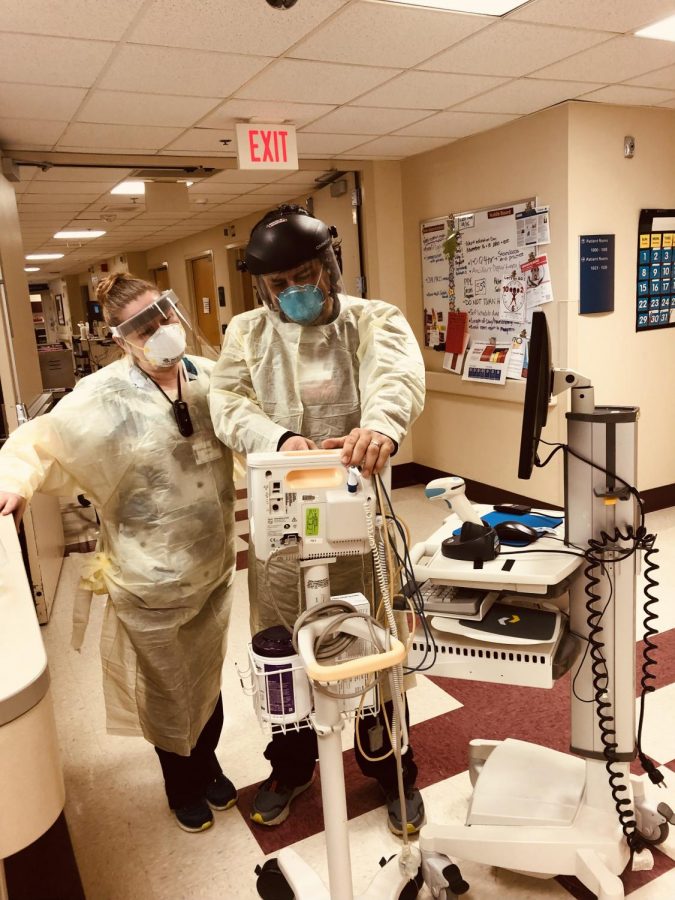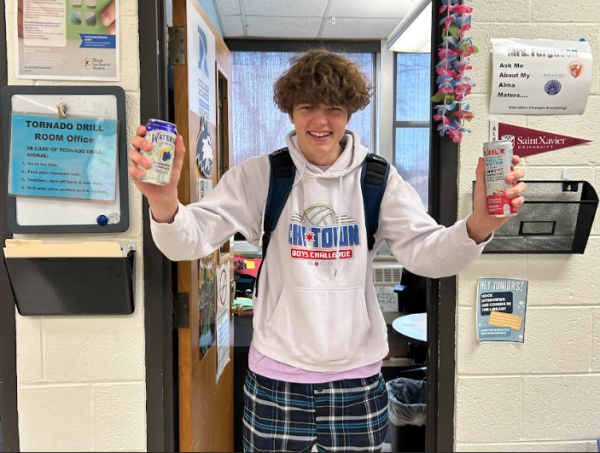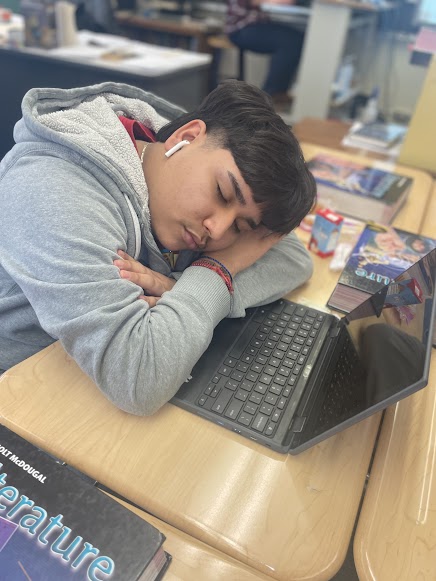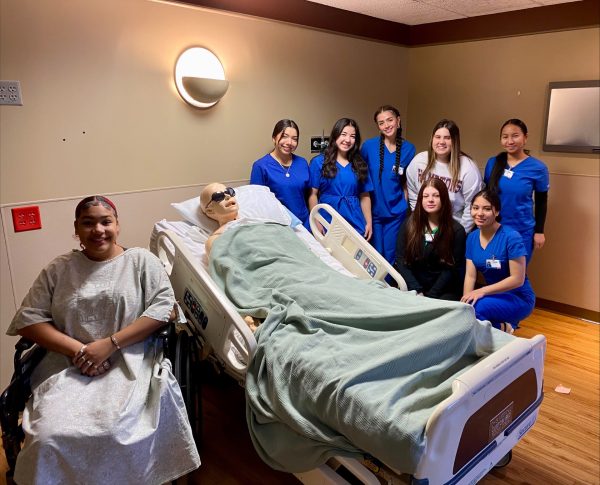Life on the COVID floor at Swedish American Hospital
Erika Spence and John Piterson examine a medical device on the Special Precautions floor at Swedish American Hospital.
In March 2020, Winnebago County received its first COVID case. Since then the Coronavirus has spread quickly, leaving around 650 people hospitalized in Rockford. As last updated, Swedish American Hospital had an increase of 40 percent of COVID patients on August 2, 2021.
Erika Spence, a certified nursing assistant at Swedish American Hospital, took the job of working on the Special Precaution Area (SPA) floor where COVID patients are admitted.
“The COVID patients need to be on oxygen, but non-COVID patients typically don’t,” said Spence. “It depends on the severity of the patient. They could be on wall oxygen, which goes up to ten liters, so they can be on highflow. After highflow they usually go to bipap (a non-invasive ventilator), and if bipap doesn’t help then they have to be intubated.”
COVID patients under Swedish American Hospital’s care have extra care compared to non-COVID patients due to the virus causing respiratory tract infections and making it difficult for people affected by COVID to breathe properly.
Employees at Swedish American Hospital who work with COVID patients are required to wear an N95 respirator mask along with a face shield to achieve a close facial fit and very efficient filtration of the airborne particles. It is very important that all employees who are in contact with COVID patients have proper protection.
“With COVID patients you typically have to wear N95 masks and a shield,” said Spence. “On the floor that I work on, you have to wear proper PPE into every room because of the new strand and rule out cases so we are now just wearing N95s to be precautious.”
Due to the high number of COVID patients Swedish American first received, several employees who provide patient care on the COVID floor caught the virus and had no choice but to quarantine for two weeks until further notice. The result was that employees who had not caught the virus often had to cover extra shifts for the employees who were mandated to quarantine.
“In the beginning of COVID it was happening pretty frequently with other employees getting sick, but lately it happens every now and then so it doesn’t happen as frequently as last year,” said Spence. “There’s only been like three times I was asked to cover someone’s shift this year.”
Spence’s time providing patient care for COVID patients gave her opportunities to meet new people, create bonds, and expand her knowledge. In one instance, she became a close friend with a female patient before her passing.
“There was this lady who was 46, and she came in starting off on four liters of oxygen. They were giving her Remdesivir (an approved antiviral drug), and she progressively took a turn for the worse,” said Spence. “She kept needing more oxygen as time went by, and she was probably there for a big three weeks and she got to know the staff. When you get close to someone, you talk about family and they share pictures of their dogs and everything and just make normal conversations with someone hospitalized for so long. She ended up coding and dying, so it was harder to take in because I got to know her, it’s almost like they became a friend.”
John Piterson, the nurse manager on the special precautions area, made the 3rd floor a place for only COVID patients to be admitted. On a daily basis, supplies are needed on the Special Precautions Area floor. Health unit technicians constantly update orders of gloves, masks, and eyewear, among other necessities.
“We’re very lucky on the SPA or special precautions area that we have health unit technicians that are usually patient care technicians (PCT’s) in background, but they also have added training on how to order supplies and put charts together. They make sure patients are accounted for, and when we get new patients, and when patients leave, and a ton of other things,” said Piterson. “ Our huts are the ones who place orders. They take inventory every day, and they make sure they write down what we need, and usually once a week they place orders for all of the supplies we need on the unit whether it’s medical supplies or other supplies such as various types of equipment.”
The highest age range of patients who come into Swedish American Hospital who have tested positive for COVID are usually 75 and older; however, COVID itself has changed, and now Swedish American is receiving more younger people aged 20 and above.
“It’s been an interesting year because when COVID first started it seemed liked it was affecting mostly older people,” said Piterson. “I mean, everyone has different definitions of ‘elderly,’ but I usually consider the eldery to be 75 and above, Since then COVID has changed and it seems to be affecting a lot of the younger people, so we see people in their 20’s, people in their 30’s, people in their 40’s and unfortunately they are presenting as just as sick if not sicker as when the pandemic first started and we had mostly eldery patients.”
There is not an actual number of COVID patients that the Special Precautions floor in Swedish American hospital has lost; however, 92 percent of the patients who go to the intensive care unit are not vaccinated. The good news is that Swedish American Hospital has had a sharp decrease in the number of deaths due to the virus.
“In our intensive care unit where patients go where they are most sick, 92 percent of all those patients are unvaccinated. If you look at all the patients that have been admitted in the intensive care unit or the critical care unit, only 8 percent of those patients are vaccinated and all the other ones are unvaccinated,” said Piterson.“I also find that once patients get down to the critical care unit, it is oftentimes difficult to turn them around. I also find that a vast majority of our patients do so because their breathing gets really bad, but we have had a sharp decrease in the number of people that have passed away.”
On average the Special Precaution area receives 86 patients a month that are in isolation for something, whether it’s because of Vancomycin resistant Enterococcus or MRSA, but most patients who are isolated on the special precautions floor are COVID patients.
“Since September of last year, when we were heading into November, we had 1,032 admissions, so if you take that number and divide it by 12, roughly on average we get 86 patients a month in our unit,” said Piterson. “ It’s a very high turnover floor and is fast paced and if you think about it, 1,000 admissions in a 12 month period is a lot of admissions, and then if you factor in other units that we have in this hospital, this hospital gets a lot of admissions.”
As head nurse of the Special Precaution Area, Piterson had the chance to meet new people and create friends with the patients.
“I was in the critical care unit as a nurse for 10 years, and I’ve also been privileged to manage a medical surgical floor. This particular unit has been unlike any other unit I’ve ever worked, and I think any of the staff would agree,” said Piterson. “ In terms of connections with patients, I’ve connected more on this floor than the other floors because unfortunately, when you have been admitted for COVID, a lot of our patients are here much longer than I traditionally saw on other floors. When somebody is here for a long period of time, you get to know the patient and the family members, and the family members are not even allowed to visit the patients with COVID, so it creates the necessity for us as nurses to get in the room and get to know these patients. That can be a good and bad thing because unfortunately, when patients don’t do well when you are so connected to the patient, it has a big affect on not just work life, so you have to be careful and try not to take it home because you have to be able to sleep at night. You have to be able to relax when it’s your time to relax because when you’ve had a patient for a really long time and they don’t do well it can affect you pretty deeply.”














